|
|
|
Sort Order |
|
|
|
Items / Page
|
|
|
|
|
|
|
| Srl | Item |
| 1 |
ID:
076848
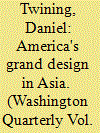

|
|
|
|
|
| Publication |
2007.
|
| Summary/Abstract |
In a dynamic Asian order featuring new centers of power, China's rise will naturally challenge Washington's ability to protect its interests in the region. In 2000, presidential candidate George W. Bush labeled China as the United States' leading strategic and military competitor. In September 2005, Deputy Secretary of State Robert Zoellick explicitly warned Beijing not to "maneuver toward a predominance of power" in Asia, suggesting that it was doing exactly that.
In the face of this challenge, the United States has strengthened the two pillars of its Cold War-era regional security posture: its hub-and-spoke system of bilateral military alliances and its forward-deployed military forces. Washington has reconfigured its permanent troop deployments in Japan and South Korea, tightened its alliance with Australia, declared Thailand and the Philippines to be major non-NATO allies, and signed a wide-ranging strategic cooperation agreement with Singapore. Meanwhile, the Pentagon has deployed significant new power-projection capabilities to the region, including attack submarines, cruise-missile destroyers, long-range bombers, and fighter aircraft stationed in Guam.
To these two preexisting pillars of its Asian security strategy, the United States is adding a third, designed to hedge against the danger of Chinese hegemony in Asia by limiting and constructively channeling China's regional ambitions. U.S. policy seeks to accelerate the economic and military rise of key Asian states with the power potential and ambitions to constrain China's ability to dominate its region. The United States is not working to contain China. Rather, U.S. policymakers are employing a radically different strategy: to preserve Washington's strategic position in the region by facilitating the ascent of friendly Asian centers of power that will both constrain any Chinese bid for hegemony and allow the United States to retain its position as Asia's decisive strategic actor. In the face of the China challenge, the United States is encouraging the emergence of new centers of strength that will not erode U.S. power but protect the U.S. position in a new Asian balance featuring emerging world powers in China, Japan, and India.
|
|
|
|
|
|
|
|
|
|
|
|
|
|
|
|
| 2 |
ID:
076844
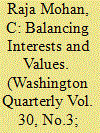

|
|
|
|
|
| Publication |
2007.
|
| Summary/Abstract |
As India celebrates the 60th anniversary of its independence, a paradox stands out. Much of the world sees a profound commitment to democracy amidst bewildering diversity as the defining feature of modern India. Yet, democracy as a political priority has largely been absent from India's foreign policy. New Delhi's conspicuous lack of emphasis on democracy in its engagement with the world is largely a consequence of the Cold War's impact on South Asia and India's nonaligned impulses in the early years of its independence. It attached more weight to solidarity with fellow developing countries and the defense of its own national security interests without a reference to ideology at the operational level.
Since the end of the Cold War, however, supporting democracy abroad as an objective has begun to factor into India's policymaking. This priority has been triggered by intensive engagement with the United States since the early 1990s. In the final days of the Clinton administration and through subsequent terms of the Bush administration, Washington has emphasized the importance of India as the world's largest democracy, underlined the role of shared political values in transforming bilateral relations, and explored options for working with New Delhi on the promotion of democracy worldwide. India has in turn confronted new challenges, such as potential failed states in the region; managing consequences of internal conflicts within its smaller neighbors; and if possible, nudging these countries toward democratic evolution. As an emerging great power in its own right, India has also been increasingly called on to contribute to international peace and security, which in the contemporary world increasingly focuses on conflicts within states.
Among these external impulses, the question of India's political values and their role in the conduct of India's international relations are bound to figure more prominently in the future policy discourse in New Delhi. Yet, the question remains: Will democracy become a more important natural component of future Indian foreign policy as many in the West hope?
|
|
|
|
|
|
|
|
|
|
|
|
|
|
|
|
| 3 |
ID:
076853


|
|
|
|
|
| Publication |
2007.
|
| Summary/Abstract |
By now it should be apparent to even the most hermetic observers that untangling the problems of Iraq will be a monumental task. As the January 2007 National Intelligence Estimate on Iraq highlighted, the country suffers from a variety of dangerous, complicated, and intertwined problems, including terrorism, pervasive organized and unorganized crime, an insurgency, a failed state, a security vacuum, and a civil war. U.S. policy toward Iraq must come to grips with all of them if it is to have any chance of engendering an environment that leads to a sustainable peace.
Recognizing that Iraq is a failed state is fundamental to understanding that it lacks the capacity to fix itself, no matter how much pressure the United States applies. Rebuilding the political, economic, and bureaucratic institutions of a failed state requires considerable resources and a long-term commitment, both of which are only possible in a secure environment. This is why fixing Iraq's security vacuum is critical to creating the conditions under which economic, political, and social institutions can begin to reemerge.
Any U.S. strategy, including the Bush administration's spring 2007 troop surge, will thus be most successful if it can influence the dynamics on the ground to create political latitude for action. The best case is that a strategic approach such as the surge will create a secure space in which to start to rebuild Iraq's shattered political, economic, and social institutions and thus threaten Iraq's warlords enough to force them to make compromises for a political settlement, just as radical Shi'a cleric Muqtada al-Sadr was forced to join Iraq's political process in 2004 when he lost control of Iraq's streets to a determined coalition offensive.
If it is going to have any chance to succeed, the surge or any other U.S. effort to stabilize Iraq cannot be left as simply a military strategy. To sustain any gains in stability, it will also be vital to forge a complimentary political agreement to achieve a sustainable peace and set in motion processes to begin to rebuild Iraq's capacities for self-governance and economic regulation. Without a truce that gets the warring parties to stop fighting, neither the United States nor the Iraqi state will be able to provide sustained security and a better life for the Iraqi people. Even the most wildly successful military strategy can do no more than create the space in which diplomatic, political, and economic efforts can build a viable new Iraq. The United States' lack of such exertions is key to the failure of its previous efforts in Iraq and essential to what is almost certainly the last chance to do so.
|
|
|
|
|
|
|
|
|
|
|
|
|
|
|
|
| 4 |
ID:
076846
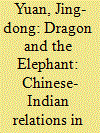

|
|
|
|
|
| Publication |
2007.
|
| Summary/Abstract |
Despite unresolved territorial disputes, mutual suspicions over each other’s military buildup and strategic intent, potential economic competition, and the changing balance of power and realignments, China and India have enjoyed 10 years of mostly uninterrupted progress in their political, economic, and security relationship. President Hu Jintao’s November 2006 visit to India, the first such visit by a Chinese head of state in a decade, marked an important milestone in the bilateral relationship. During Hu’s visit, the two governments issued a joint statement highlighting a 10-point strategy to elevate the relationship and signed more than a dozen agreements to strengthen cooperation in trade, investment, energy, and cultural and educational exchanges.
Hu’s visit to India injected optimism and high expectations for Chinese-Indian relations, but the challenges ahead remain daunting. They include unresolved territorial disputes, mutual suspicions of each other’s intentions, and power realignments at the global and regional levels. The substance and consolidation of the bilateral relationship will depend on how the world’s most populous and fastest-growing states manage these challenges as they continue their ascent to great-power status. Moreover, as the world becomes increasingly affected by the rise of these two Asian powers’ phenomenal economic growth and political influence, how Beijing and New Delhi handle their bilateral relationship will be critical for regional and global peace and prosperity in the coming years
|
|
|
|
|
|
|
|
|
|
|
|
|
|
|
|
| 5 |
ID:
076847


|
|
|
|
|
| Publication |
2007.
|
| Summary/Abstract |
Since the end of the Cold War, New Delhi has been slowly but surely forging a comprehensive relationship with Tehran based on energy and commercial cooperation, infrastructure development in Iran and beyond, and purported military and intelligence ties. Iran holds particular importance for India as it provides unique access to Afghanistan and Central Asia, two theaters in which India seeks to project greater influence.
Curiously, the Indian-Iranian détente did not attract significant U.S. government attention until the fall of 2005 when, at the direction of President George W. Bush, Congress undertook deliberations to change U.S. law to permit a civilian nuclear deal with India. With the Iranian nuclear crisis deepening in the background, opponents of the deal reasoned that it would enervate the very global nonproliferation regime that was needed to compel Iran to halt fissile material production. Critics and even a few champions of the initiative were wary of the strategic and military ties that New Delhi and Tehran were trumpeting to their citizens while downplaying them to U.S. audiences. To allay these concerns, U.S. officials argued that India's ties with Iran are tied to the former's mounting energy needs. This contention justified the Indian-U.S. nuclear deal, which would diminish India's dependence on Iran, and facilitated the conclusion that Iranian-Indian ties are benign to U.S. interests even if they imply future policy disagreements between New Delhi and Washington.
Although India as a major energy consumer certainly seeks a steady supply of resources, this one-dimensional characterization of Indian-Iranian ties is incomplete. The Indian-Iranian relationship has much more to do with India's great-power aspirations and New Delhi's concomitant expansive agenda for Central Asia and beyond, within which energy is only one, albeit important, consideration. New Delhi has a finely tuned balancing act to sustain. How far can India expand its bilateral ties with Iran while deepening and broadening its critical relations with the United States, Israel, and a host of other states that are wary of Iran?
|
|
|
|
|
|
|
|
|
|
|
|
|
|
|
|
| 6 |
ID:
076845
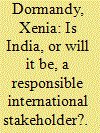

|
|
|
|
|
| Publication |
2007.
|
| Summary/Abstract |
It has become a cliché that the key strategic challenges facing Washington and the wider international community, such as energy, water, terrorism, economic development, and nonproliferation, cannot be solved by the United States alone. Although the United States unarguably retains its post-Cold War preeminent position, events since the September 11 attacks have shown the limitations of Washington's hard and soft power. Meanwhile, the power of Europe and Japan are waning as they face internal distractions that limit their influence, while China's is rising globally and in Asia, arguably the most important region to the United States strategically. China's increasingly high military spending has built strong and capable armed forces, and its economic power is developing swiftly, with annual growth averaging nearly 10 percent over the past 20 years. From a low following Beijing's crackdown on the 1989 Tiananmen Square protests, China's influence is growing as well.
These power fluctuations compel the United States to seek out like-minded allies that will proactively help to resolve global as well as Asian challenges. In September 2005, Deputy Secretary of State Robert Zoellick asked whether China would rise peacefully to become a "responsible stakeholder" that "recognize[s] that the international system sustains their peaceful prosperity, so [that] they work to sustain that system." He went on in the speech to solicit China's cooperation on a number of global issues, including North Korea, nonproliferation, and terrorism. Considering India's significant rise over the past few years, the same question could be asked of India. Largely unnoticed by the global community, India has ascended to the world stage over the past 15 years, building on its economic reforms of the early 1990s and nuclear tests in 1998. In addition to an economic growth rate second only to China's, at 8 percent annually over the past three years, New Delhi continues to retain its position as leader and cofounder of the Non- Aligned Movement (NAM) and unofficial head of the developing world. India has the third-largest army, fourth-largest air force, and seventh-largest navy worldwide and is eagerly lobbying to be considered a global player, actively seeking a permanent seat on the UN Security Council.
Both President George W. Bush and then-Prime Minister Atal Bihari Vajpayee have described the bilateral relationship as that of "natural partners." The United States has made India one of its central foreign policy foci and a powerful success story, especially since President Bill Clinton's triumphal five-day visit in 2000. Considering its capabilities, will, interests, and values, India would seem to make an ideal partner in the region and even globally. Will India live up to the U.S. definition of an "international stakeholder"? What might be the constraints on its desire or ability to do so?
|
|
|
|
|
|
|
|
|
|
|
|
|
|
|
|
| 7 |
ID:
076849
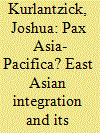

|
|
|
|
|
| Publication |
2007.
|
| Summary/Abstract |
Most days, the street outside the Thai embassy in Phnom Penh fills early with pedicab drivers shuttling old women to market. One winter day in 2003, however, a far different crowd gathered outside the Thai mission. Cambodian newspapers had misquoted a Thai television pop star as calling Cambodians "worms" and questioning whether Angkor Wat, Cambodia's ancient temple complex, should be returned to Thailand. Stoked by the report, mobs attacked Thai-owned businesses across Phnom Penh, causing millions of dollars worth of damage.
A decade ago, a conflict between two East Asian nations would have been resolved by the region's only major power, the United States, which had dominated trade, diplomacy, and culture in East Asia since World War II. In this case, Cambodia and Thailand sought out China to serve as an informal mediator. After the Chinese ambassador in Cambodia and Thailand to resolve their dispute, Chinese vice foreign minister Wang Yi helped the Thai and Cambodian representatives lay out their grievances. Chastened, the two sides began to resolve their dispute.
The Cambodian-Thai case is hardly unique. Over the past decade and particularly since the Asian financial crisis of the late 1990s, East Asia has begun to integrate, forming the beginnings of a true regional community and looking to actors within the region such as China, rather than the United States, to resolve security and economic disputes. Across East Asia, governments and leaders are developing their own institutions and intraregional trade patterns. They even have begun holding their first truly regional meeting, the annual East Asia Summit (EAS), which first convened in December 2005. Outside government, average people have developed a growing pan-Asian consciousness, the result of closer commercial links, the rise of an East Asian middle class, and the penetration of Asian pop culture products into households. In subtle ways, people across East Asia, like Europeans after World War II, are beginning to think of themselves as citizens of a region.
In recent years, as East Asia has been building regional ties and nascent institutions, the United States often has been absent from the region. By undervaluing East Asian integration, Washington has created the impression that it views East Asian regionalism as a threat to U.S. power. Yet, Asia's new identity and institutions need not be a challenge to the United States, and Washington must remain engaged with the region, which is now the engine of global economic growth and potentially the world's most dangerous security environment. If the United States can revamp its East Asia policy to capitalize on the benefits of pan-Asian institutions, it can remain vital in an era of Pax Asia-Pacifica.
|
|
|
|
|
|
|
|
|
|
|
|
|
|
|
|
| 8 |
ID:
076850


|
|
|
|
|
| Publication |
2007.
|
| Summary/Abstract |
On July 31, 2006, after more than 47 years in power in Cuba, Fidel Castro ceded his government, Communist Party, and military responsibilities to his brother Raul. As of late April 2007, the 80-year-old Fidel had not appeared in public since ceding power, even at events designed to revere him. No new policy initiatives have been taken in his name, and no line of obsequious officials has been reported waiting at his door. Now, even as the state-controlled media continue to lionize him, Castro is transubstantiating into a historical artifact, even though he remains the official head of state. As the seasons change and the Cuban people stoically go about their business, the possibility that Fidel will return to power seems ever more remote. He has been glimpsed briefly a few times on Cuban and Venezuelan television, looking emaciated and confused following complications from as many as three major intestinal surgeries…Cubans have seen and heard a pallid, vacated version of the previously acute and always voluble Fidel, the familiar grandstanding figure who for so many years posed and strutted on the world stage.
Some foreign observers in Havana have concluded that these appearances have been choreographed at least in part by his successors to dampen whatever expectations may be left that Fidel will be able to fully function again in office. Nothing of what was seen of his diminished physical condition seemed calculated to reassure those who hope for his return. Although he could yet reappear in the halls of power in Havana, the evidence of his physical debilitation and cognitive inconsistencies suggests that if he does return, it will be in an emeritus capacity. In fact, the new leadership and probably the bulk of the Cuban people seem to have moved on, relieved to no longer endure his endless monologues while suppressing all hope of relief from his strangling ideological intransigence. There is even reason to suspect that Raul and others around him do not want Fidel back. For example, surely it was not happenstance that Raul commented, perhaps in jest and perhaps not, in an impromptu discussion he initiated with foreign reporters in Havana in February 2007 that although his brother speaks by phone with other government officials, "it is my good fortune that he never calls me."
The fading Fidel still has many ardent followers on the island. Yet, most Cubans have high expectations that his abdication will soon make important changes possible. They have been feeling the first blush of hope that a more tolerant, economically liberalized, outwardly oriented era may be dawning. In a departure from Fidel's standard rhetoric, for example, the new regime is admitting that the country's economic problems are systemic, the results of corruption, inefficiency, and overly rigid central planning. Internal scapegoats and the U.S. economic embargo are no longer incessantly being blamed. Previously persecuted groups, including intellectuals, artists, and homosexuals, as well as deeply disaffected youth are beginning to see in Raul the makings of a Communist reformer. It is not yet clear, however, whether or not those hopes will be viciously dashed.
In early April 2007, his regime began implementing a tough new labor code intended to wring corruption, inefficiency, and malfeasance out of the workplace. Other measures to extirpate illegal satellite television antennas and to restrict Internet use to the approximately 2 percent of the populace now with access have also demonstrated the new regime's determination to maintain absolute political control. Raul has often in the past taken the lead in implementing such unpopular, draconian measures. As a result, he is mostly hated and feared by the Cuban people, remembered as his brother's most brutal executioner and hard-line enforcer. Unlike Fidel, he is dour and uncharismatic and will therefore have difficulty softening his image or making restrictive new policies seem palatable to the populace
|
|
|
|
|
|
|
|
|
|
|
|
|
|
|
|
| 9 |
ID:
076851


|
|
|
|
|
| Publication |
2007.
|
| Summary/Abstract |
The costs and unmet expectations of the democracy promotion project in Iraq and the wider Middle East have sparked a broad debate about the future of U.S. grand strategy. In the chorus for change, some suggest that the United States should return to such principles of liberal internationalism as multilateralism and financial beneficence, which marked the golden era of U.S. diplomacy in the years immediately following the end of World War II. Others insist that U.S. foreign policy needs to be reestablished in a more pragmatic realism that responds to the global balance of power and resists the overuse of military muscle to promote democracy around the world.
Greater reliance on U.S. economic power can inject more prudence into foreign policy without abandoning the historical U.S. goal of promoting freedom and political reform around the world. The United States possesses the largest and most vibrant market in the global economy and can integrate this unique political asset more effectively in the larger global struggle against terrorism and radical Islam. Unilaterally eliminating trade barriers on imported goods from moderate Islamic states critical to combating terrorism, such as Bangladesh, Ethiopia, Indonesia, Kenya, Malaysia, Mali, Mauritania, Nigeria, Pakistan, the Philippines, Tanzania, and Turkey, could strengthen Washington's capacity to promote political moderation and cultivate local influence within these countries.
As foreign businesses and workers come to depend on U.S. consumers for profits and jobs, they become important allies in internal struggles taking place around the world between the forces of modernization, globalization, and tolerance against those of tradition, introversion, and hatred. Expanded access to the U.S. consumer market cultivates an enduring foundation for common political interests with the United States by creating jobs and economic opportunities in potential havens for terrorist activity while strengthening liberty and domestic political reform abroad
|
|
|
|
|
|
|
|
|
|
|
|
|
|
|
|
| 10 |
ID:
076852
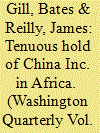

|
|
|
|
|
| Publication |
2007.
|
| Summary/Abstract |
China’s constructive approach with Africa fits squarely within its global strategy to promote China as a peacefully developing and responsible rising power seeking a harmonious world. China does look to Africa’s resources to fuel China’s growth. More broadly, however, Beijing seems to sense that Africa is on the verge of an economic and political renaissance. It wants to get in on the ground floor and be an integral and valued part of that transformation.
Within that broader strategy, China’s “corporate engagement” strategy in Africa consists of several elements. Top Chinese leaders and diplomats create a favorable environment for Chinese investment in Africa through a mixture of prestige diplomacy, economic assistance, and diplomatic support for African leaders. At home, China’s economic bureaucratic agencies encourage Chinese state-owned enterprises (SOEs) to increase their investment and trade with Africa. China’s SOEs implement Beijing’s aid projects, extract strategic natural resources for export back to China or for profit in the international marketplace, and expand their manufacturing bases in China. Chinese workers staff Chinese projects efficiently and at low cost, and Chinese migrants build trade networks and supply chains linking China and Africa. At least, that is the idea.
Since 2000, this impressive policy push has rapidly advanced China’s core strategic, economic, and diplomatic objectives in Africa. Chinese corporations have secured long-term access to key strategic resources. Economic policymakers have leveraged ties to the continent to build a more globalized network of large transnational corporations. The prospects for economic growth and investment have encouraged African leaders to support China’s broader diplomatic effort to portray itself as a peacefully rising power interested in “win-win” solutions and have helped lure African capitals to drop official ties with Taipei in favor of diplomatic relations with Beijing.
Most analysts, however, tend to exaggerate the prospects of China’s corporate engagement in Africa. As it deepens, the Chinese government will more likely find itself hamstrung by what theorists call a powerful “principal-agent” dilemma: an increasing set of tensions and contradictions between the interests and aims of government principals—the bureaucracies based in Beijing tasked with advancing China’s overall national interests—and the aims and interests of ostensible agents—the companies and businesspersons operating on the ground in Africa.
As China’s Africa strategy depends on an ever-increasing number of bureaucratic principals and corporate agents, contradictions between them will likewise increase. There is already ample and growing evidence of Chinese corporations and entrepreneurs taking steps that are at odds with Chinese government interests, creating problems for Beijing’s attempts to promote a positive and constructive image for Chinese engagement in Africa. Looking ahead, Beijing’s ability to rely on its corporate agents to dependably advance its strategic, economic, and diplomatic interests in Africa will further erode. This in turn will likely present new challenges to China’s global influence and overall soft-power strategy.
|
|
|
|
|
|
|
|
|
|
|
|
|
|
|
|
|
|
|
|
|